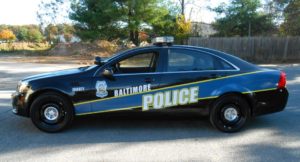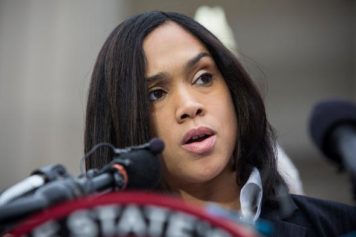
Baltimore Detective Sean Suiter was shot in the head and killed with his own weapon one day before he was scheduled to testify before a federal grand jury in a police corruption case. (Photo: Wikimedia Commons)
A Baltimore police officer was killed with his own gun the day before he was scheduled to testify in a corruption case involving his own department, fueling speculation the killing was an inside job involving law enforcement. The slaying, and the police task force accused of criminal activity place the issue of police corruption in the spotlight. When the police engage in gang activity, drug dealing and robbery, the question that arises is whether this official corruption reflects a few bad apples or a rotten orchard.
Baltimore homicide detective Sean Suiter — was a father of five, an 18-year veteran of the Baltimore police department, a and former Navy officer — was gunned down in West Baltimore on November 22, reportedly shot in the head with his own gun, at close range and after a struggle. Suiter was scheduled to testify the following day as a witness before a federal grand jury in the case of the department’s elite firearms crime task force.
Eight members of the squad have been indicted and charged with shaking down drug dealers on allegations of stealing money, drugs and property from civilians over the course of two years. The Gun Trace Task Force was formed to remove illegal firearms from the city. Prosecutors accuse its members of defrauding the police, writing phony police reports and lying to investigators, and using their authority as law enforcement to threaten, rob, extort and detain people under false pretenses.
Although Suiter’s killer is unknown and it is conjecture to suggest his fellow officers are responsible, it is worth noting the suspicious circumstances surrounding his death. Suiter is the first on-duty officer killed in a decade, and there is a $215,000 reward for information leading to the arrest of the offender. No suspects have been arrested and only a vague description of a suspect, in contrast to the nearly immediate arrest that is typical after a police killing. As The Intercept reported, the Harlem Park neighborhood where the crime scene is located was placed on occupation-style lockdown to preserve and collect evidence, on the grounds that the murder of a police officer is a special case and unacceptable. “As police cars lined the perimeter of Harlem Park for days, residents were unable to enter their neighborhoods without showing IDs,” The Intercept wrote. “Some complained about helicopters flying above their homes, flashing lights from police cars, and being subject to harassment and pat-down searches. Non-residents were barred from entering. On social media, many called to #FreeWestBaltimore.”
On November 14, a Philadelphia police officer, Eric Troy Snell, 33, was arrested and charged with conspiring with the Baltimore officers to sell cocaine and heroin taken off the streets of that city. Federal authorities accused Snell of threatening the children of a Baltimore cop who pleaded guilty and acting as the link between the drug-dealing Baltimore cops, and his brother who sold the drugs in Philadelphia. According to the Baltimore Sun, Snell is a former Baltimore cop who attended the police academy with Detective Jemell Rayam, one of the eight indicted Baltimore officers. Snell allegedly conspired with Rayam, selling and distributing the cocaine and heroin and sharing the proceeds. He faces 20 years in prison. The nine indicted men reportedly pocketed hundreds of thousands of dollars while searching the cars and homes of innocent people and criminals alike. Four detectives, including Rayam, Momodu Gondo, Evodio Hendrix and Maurice Ward, pleaded guilty to federal racketeering and will be sentenced next year. Four others, including Detectives Marcus Taylor and Daniel Hersl and Sgts. Thomas Allers and Wayne Jenkins, are challenging the charges and begin trial in January.
“Police corruption has always been a core feature of the war on drugs,” Alex Vitale a sociology professor at Brooklyn College and author of “The End of Policing” told Atlanta Black Star. “When you create a massive black market, there’s going to be police corruption. It’s unavoidable. It doesn’t mean there is bad faith by the people in charge, but police corruption.”
Vitale noted that police are arrested on a regular basis for drug violations. “This is exacerbated by another factor — these specialized units, gun units, anticrime units. These provide an excessive risk of corruption,” he added, using the Rampart Scandal in Los Angeles as a prime example. That scandal of the late 1990s stemmed from the widespread corruption of the elite CRASH anti-gang unit (Community Resources Against Street Hoodlums) in the LAPD’s Rampart Division. More than 70 police officers were implicated in acts of corruption such as stealing and selling drugs, bogus arrests, perjured testimony, unwarranted beatings and shootings, planting guns on unarmed civilians and hiding evidence. Interacting with gang members to collect intelligence presumably for crime prevention, police officers assumed the look, conduct and mannerisms of gang members. The corruption scandal cost the city of Los Angeles an estimated $125 million in civil suit settlements.
Police corruption can take three forms, Vitale says. “It can look like what existed in New York until (Frank) Serpico and the Knapp commission, when the detective ranks were involved in payoffs, and everyone was in the gambling, prostitution and drugs. That is the worst case where the whole enterprise is involved,” he said. Serpico is a former NYPD police officer who spoke out against police corruption in the late 1960s and early 1970s. He was shot in the face during an attempted drug arrest when his fellow officers would not come to his aid. Serpico testified before the Knapp Commission, which was established to investigate his claims of corruption in the department.
The second form of corruption is a gang unit or a vice unit that is engaged in corruption but is insulated from the department. The third type is where individual officers maintain their own criminal enterprise. The institution-wide corruption is not as common anymore, Vitale insists, while the other two kinds of corruption are endemic. Moreover, the officers in these units maintain an “ends justify the means” approach, in which they are set loose to go after the worst of the worst. “But these units are always notoriously insular, so they do their best to separate themselves from the rest of the police department,” Vitale said. “They are the best, they’re going after the worst, they aren’t open to public scrutiny and can’t tell the rest of the department what they’re up to.”
Professor Vitale believes the solution to ending police corruption is simple and straightforward. “The answer: End the war on drugs. That’s how we got rid of the corruption of the 1920s and 30s, and then the police had nothing to do with it. No one was getting buried anymore, no one was getting extorted anymore,” he said. “You can’t have this type of prohibition without corruption, because there is too much money involved, and the temptation is just too great. When you create a black market like this, you’re going to have corruption,” Vitale added.
Police abuse, violence and corruption are nothing new, not in the Black community, where people have complained about law enforcement practices for years. This is why some continue to protest or take a knee for those who bodies who are lost to police brutality. But who will take a knee for Detective Sean Suiter?

